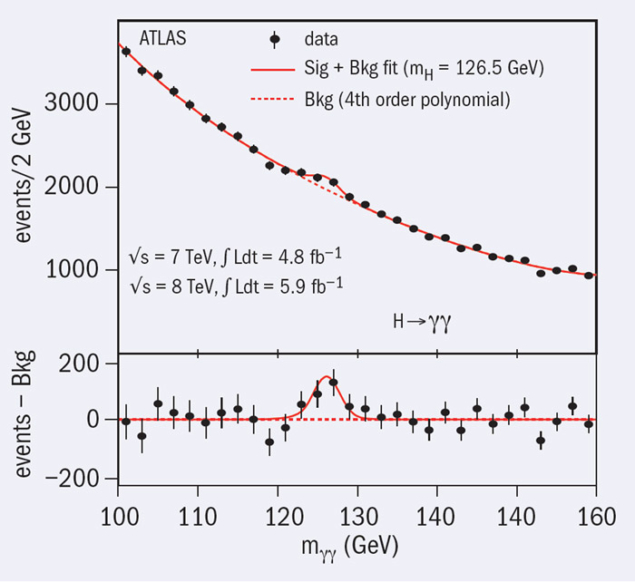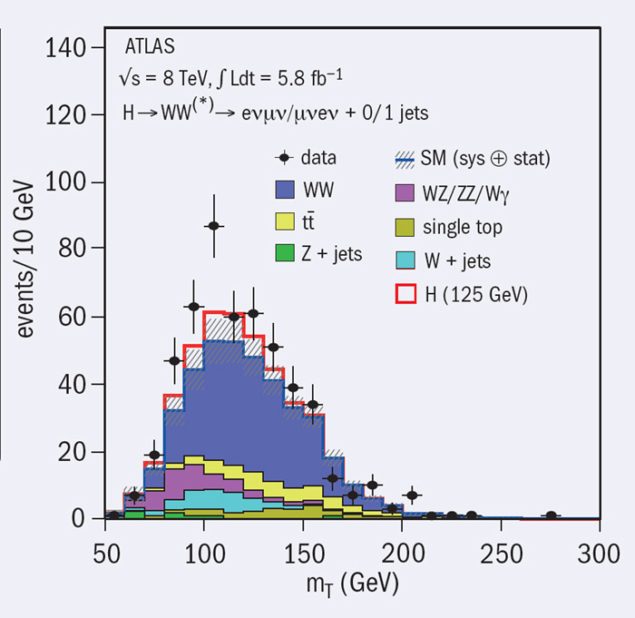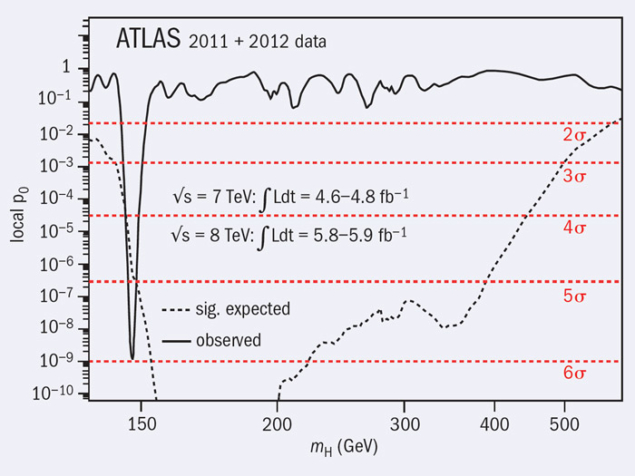
By the end of 2011, hopes for the discovery of the Higgs boson during 2012 were riding high on the back of tantalizing hints in the 5 fb–1 data sample. The aim was to quadruple the data set this year, with the added benefit that increasing the centre-of-mass energy from 7 TeV to 8 TeV brings a higher predicted rate of Higgs production. The first planned checkpoint was for the ICHEP 2012 conference and in the weeks preceding it the LHC performed better than ever, resulting in a total delivered luminosity of more than 6 fb–1 at 8 TeV. Thanks to the expertise and continued dedication of many people, the ATLAS detector was in great shape, and 90% of the delivered data were recorded and passed the strict quality requirements to go forward for analysis.
The strategy
The ATLAS strategy in preparation for the early ICHEP milestone was to focus first on the most sensitive decay modes, the decay of the Higgs boson to two photons (γγ), to two Z bosons or to two W bosons. The W and Z bosons are identified from their most clear final states. The two Zs decay to four leptons (llll), electrons or muons, and the W pair is identified in the mixed-flavour final state with an electron, a muon and two neutrinos: WW→eνμν. The γγ and ZZ→llll modes have excellent mass resolution because the Higgs boson decays entirely into visible, well measured particles. However, they have quite different signal-to-background rates and features, requiring appropriate analysis strategies. By contrast, the presence of two invisible neutrinos means that the WW mode has low mass-resolution.
For each final state, the approach was not to look in the signal region of the 2012 data until the analysis procedure was frozen, to avoid any bias in tuning the event selection criteria. The selections were optimized using simulated samples and control regions in the data. These are samples of events with configurations that cannot come from a Higgs signal but which allow salient features of the data to be compared with simulation.
For the γγ final state, the mass distribution of the photon pair in events with two energetic photons is shown in figure 1a. The background to the Higgs signal is dominated by genuine γγ events from known processes, plus events with one or two hadronic jets misidentified as photons. This background forms a smoothly falling spectrum on top of which there is a visible bump around 126 GeV. However, this distribution tells only part of the story. The potential significance of the signal is higher in subsets of the data that have better mass resolution. The resolution depends on whether the photons are in the central or forward parts of the detector, and also on whether one or both photons have “converted” by the process γ→e+e–. Furthermore, the signal-to-background ratio also changes according to the number of additional hadronic jets in the event because this characterizes different Higgs-production mechanisms. The data were divided into 10 subsets, for each of which the background shape was derived by fitting the data themselves. By evaluating the probability that fluctuations of the smooth background could create the bump, the local significance at 126 GeV is found to be equivalent to 4.5 standard deviations (σ).

Comparing the mass distribution from the two-photon sample with the distribution in figure 1b, where the mass is calculated from the four leptons in ZZ→llll events, the situation is quite different. The predicted signal to background in the interesting mass range between 120 and 130 GeV is much larger for the ZZ final state, with about half of the background coming from genuine ZZ events and half from other processes. The background shape is more complicated than in the γγ case but the expected features are well reproduced by simulation. The small peak in the distribution at 125 GeV has a local significance of 3.4σ.

Combining the ZZ→llll result with the γγ result and with all of the channels measured in 2011 brings the local significance to the pivotal threshold of 5.0 σ, as was announced to cheers at the 4 July seminar. Moreover, the signal masses measured in these two high-resolution channels are consistent, with an overall best-fit mass of 126.0 ± 0.4 (stat.) ± 0.4 (syst.) GeV.
The WW→eνμν analysis was ready a few days after the seminar and is included in the publication. Although the mass cannot be calculated, a transverse-mass variable mT can be formed from the measured electron and muon and the missing transverse energy in the event that arises from the unobserved neutrinos. Figure 1c shows the distribution of mT, with the predicted broad signal from a 125 GeV Higgs boson superimposed on the known backgrounds. The visible excess of events over background lends further evidence for the presence of a signal, bringing the overall significance to 5.9σ, corresponding to a one in 600 million chance that the known background processes could fluctuate to give such a convincing excess.

It came as something of a shock that the discovery threshold was reached so early in 2012. After more than 20 years of development, the detector has proved that it is capable of measuring leptons, photons, jets and missing energy with excellent precision, and it is operating with remarkable efficiency. This performance has been maintained even though the LHC is delivering higher luminosity than ever, with more proton–proton interactions per bunch crossing than foreseen. The trigger menus have been fine-tuned to select the most interesting events. The intricate process of reconstructing and distributing millions of events across the worldwide LHC Computing Grid in a matter of days runs smoothly; the ability to go from recording the last data to announcing a discovery just a couple of weeks later was incredible. In all aspects of the endeavour, people were prepared to work without sleep to ensure that the next step went without a hitch. The excitement as the data were revealed for the first time was tangible, and the thrill of the announcement on 4 July was shared by the collaboration around the world, from the lucky few in the CERN auditorium to collaborators at their home institutions and the attendees at the ICHEP conference in Melbourne.
The celebratory champagne has been drunk and the next stage of the work is beginning. The question on everyone’s lips now is whether this new particle has the features of the Standard Model Higgs boson. Undoubtedly, it is a brand-new boson, and we look forward to getting to know it better.
To explore all our coverage marking the 10th anniversary of the discovery of the Higgs boson ...
Further reading
Phys. Lett. B, arXiv:1207.7214





